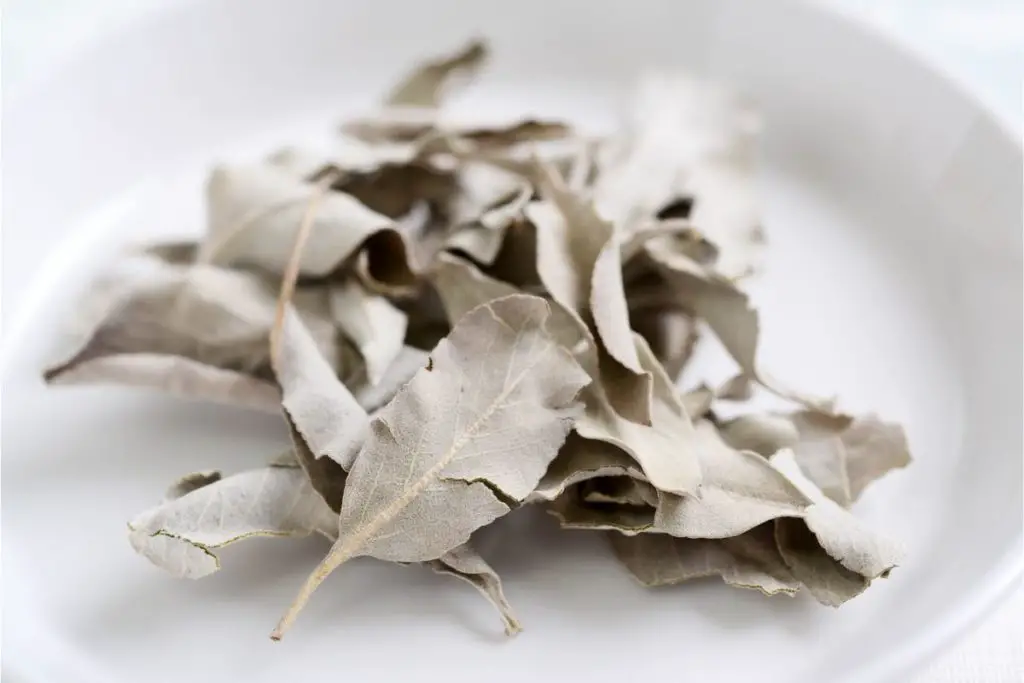Sage has a unique, earthy flavor and a strong aroma. It is packed with nutrients and compounds and is delicious when used in a variety of dishes. You can make sage and onion stuffing which can be served with chicken or turkey.

It goes well with pork, so why not try apple-sage pork chops. It can even be used in pasta such as rigatoni with butter, sage, and parmesan. Try it with fish such as prosciutto-wrapped halibut with a sage and butter sauce.
However, you don’t need a lot of it to add flavor so what do you do if you have too much? It only lasts for a week in the fridge and you might not want to use it every day. The alternative is to freeze it, and, in fact, sage does freeze well. In this article, we will tell you how to freeze sage and how to defrost it.
How To Freeze Sage
There are two methods of freezing sage, either as leaves in a bag or in ice cube trays. We prefer the ice cube tray method. By putting the sage in water, less flavor is lost than if you freeze the leaves as they are.
How To Freeze Sage Leaves
1. Prepare your sage leaves.
Pick the sage leaves off their stems, getting rid of any that are damaged.
2. Wash the sage leaves.
Dry them afterward. If you put wet sage leaves in the freezer, ice crystals may form, and the flavor will diminish, and the leaves will become mushy when defrosted.
3. Put the sage leaves in freezer bags.
It is a good idea to put as many sage leaves you feel you can use within a week into each bag so as to avoid waste. Make sure that you squeeze out all the air from the bags so that freezer burn doesn’t occur. The sage will still be safe to use but it will lose taste and texture and as a result, will be useless. Put a label on the bags with the date frozen and the contents.
4. Freeze.
How To Freeze Sage In an Ice Cube Tray
1. Prepare the sage leaves.
Get rid of any damaged leaves. They won’t improve with freezing.
2. Wash the sage leaves.
You don’t need to dry the leaves because you will be putting them in water in the ice cube tray.
3. Slice the sage leaves finely.
4. Put the sage into the slots of an ice cube tray.
A tablespoon or two should be enough for each slot. You can buy ice cube trays with larger slots if you want to freeze a larger amount of sage. Pour water over the sage but don’t fill the slots right up to the top. This is because the water will expand when it is in the freezer. Once you have done this, put the ice cube tray in the freezer and freeze for a few hours until the cubes are frozen solid.
5. Put the ice cubes in freezer bags.
Squeeze out all the air from the freezer bags to prevent freezer burn and put a label on the bags with the date frozen and the contents.
6. Freeze.

Tips For Freezing Sage
- If you want to use the sage in drinks, you can freeze whole sage leaves in the ice cube slots. A lovely drink is a tequila sage smash. Smash up some sage leaves, and pour tequila, Cointreau, and agave over them. Garnish with sage leaves.
- Use defrosted sage leaves to infuse olive oil.
- Make a herb mix in the ice cube slots. If you need to use different herbs in your dish this is an excellent idea. Other herbs and spices that go well with sage are garlic, rosemary, and thyme. Even parsley and basil are good choices.
- Try using sage to make sage butter. It freezes really well. All you have to do is chop the sage and mix it into softened butter. Roll into a sausage and cover in cling film. Make sure that you cover it tightly to prevent freezer burn. Wrap it in two layers to be absolutely certain. It can be defrosted in the fridge and lasts for a month. If you want to add it to a dish, just cut a slice and put it in the pan. You could also make sage and garlic bread. Garlic and sage are a match made in heaven and this is a great way to have something a little different.
For How Long Can You Freeze Sage?
You can freeze sage for up to six months. After this time, it begins to lose flavor so is, in effect, useless. The great thing about sage is the strong, earthy, flavor it has.
How Do You Defrost Sage?
If you have frozen your sage in an ice cube tray, you can throw the cubes straight into the dish. They will melt in no time. If you want whole sage leaves, put a cube in a sieve and run warm water over it. The cube will melt, and you will have your sage leaf.
However, if you have frozen sage leaves in a freezer bag, defrost them in the fridge. It will take just a few hours.
Can You Refreeze Sage?
It is perfectly safe health-wise to refreeze sage but we don’t recommend it. If you freeze, defrost, and then refreeze, the flavor can be lost, and the sage leaves can end up a soggy mess.
Is It a Good Idea To Freeze Sage?
Yes, it is a great way to preserve sage if you have a glut of it. You may grow it in the garden and it all of it is ready for picking at the same time. In fact, you will be hard-pressed to tell the difference between fresh and frozen sage leaves.
Frequently Asked Questions
Hopefully, you now know all there is to know about freezing sage but in case you are still curious, we have answered a couple of questions here.
Can you freeze all types of sage?
You may not know this but there are many different varieties of sage such as white sage, grandmother sage, pineapple sage, and New Mexico sage. The one we tend to use most is the common or garden sage but all types of sage can be frozen.
Can you freeze sage and onion stuffing?
Yes, you can freeze sage and onion stuffing. When you have cooked it and cooled it down, wrap the dish in cling film and then aluminum foil. Freeze. When you need to use it, thaw it in the fridge overnight and then take off the foil and cling film. Warm the stuffing in the oven at 375 F for around twenty minutes.
